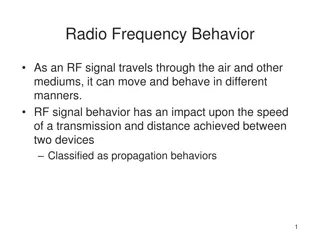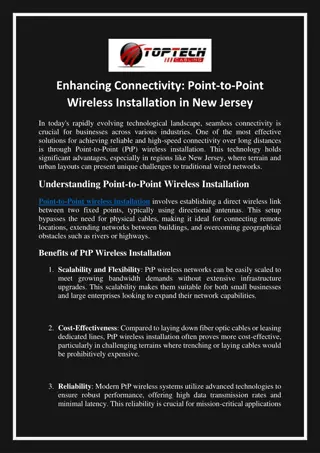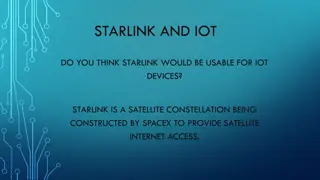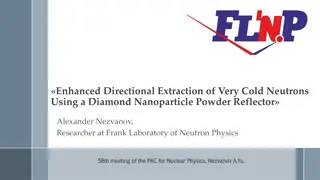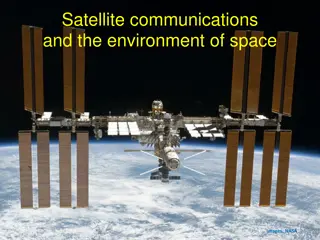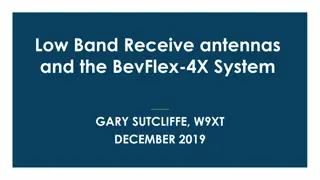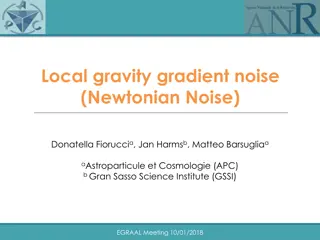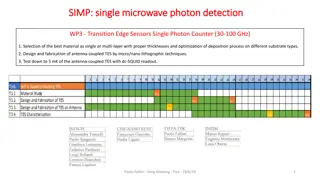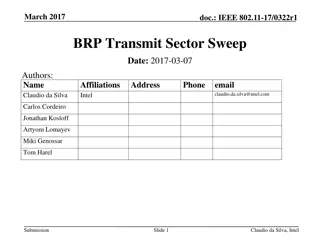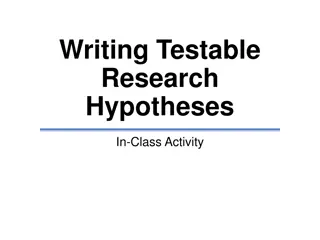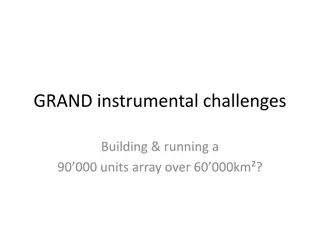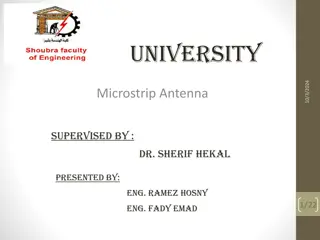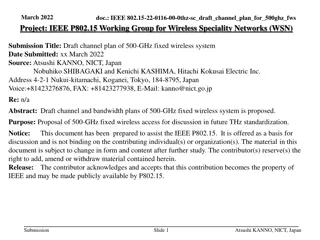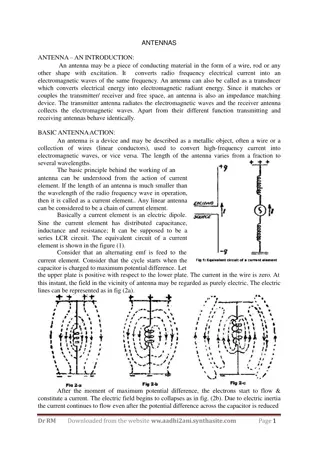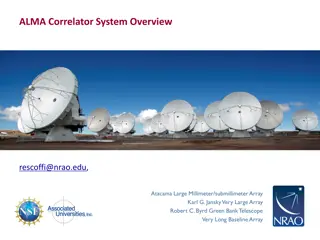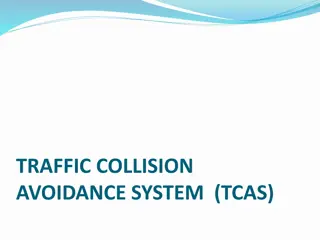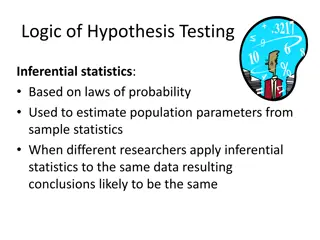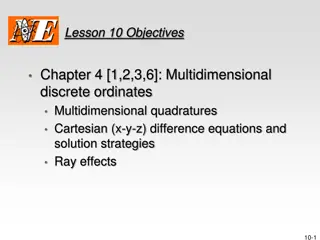Challenges and Opportunities in Satellite Connectivity Systems
Satellite connectivity systems face challenges such as handset emissions, limited bandwidth, and interference issues, but also present opportunities for innovative technologies like high-gain systems and phased array antennas. The European Union's MSS S-band spectrum allocation in 2009 is a notable
0 views • 10 slides
Understanding Coordinated Beamforming and MU-MIMO in IEEE 802.11-23/1998r0
This document delves into the intricacies of Coordinated Beamforming (Co-BF) and MU-MIMO techniques in the context of IEEE 802.11-23/1998r0 standard. It explores the concept of nulling in Co-BF, handling more Rx antennas than streams, Zero-Forcing precoding to eliminate Multi-User Interference (MUI)
2 views • 22 slides
Understanding Antenna Patterns and Directivity of Infinitesimal Dipole Elements
Explanation of the infinitesimal dipole element used in wire antennas, calculation of radiated fields, radiation patterns, directivity, and far-field patterns. Includes illustrations and equations for a comprehensive understanding.
7 views • 28 slides
Understanding Horn Antennas in Microwave Technology
Horn antennas are integral in microwave technology, offering high gain, low VSWR, and wide bandwidth. Widely used for radio astronomy, satellite communication, and more, horns play a crucial role in various applications. Learn about the design, characteristics, and radiation properties of horn anten
6 views • 21 slides
Understanding Radio Frequency Behavior and Propagation Behaviors
Radio frequency signals exhibit various behaviors as they travel through different mediums, affecting transmission speed and distance between devices. Propagation behaviors include absorption, reflection, scattering, refraction, and diffraction, impacting wireless network performance. Understanding
2 views • 32 slides
Enhancing Connectivity - Point-to-Point Wireless Installation in New Jersey
Point-to-Point wireless installation involves establishing a direct wireless link between two fixed points, typically using directional antennas. This setup bypasses the need for physical cables, making it ideal for connecting remote locations, exten
2 views • 2 slides
Step-by-Step Guide for Creating Pictorial Drawings
Learn how to create pictorial drawings step by step with detailed instructions and visuals. Follow along to sketch objects viewed from different directions such as antennas and toggle switches. Understand the importance of orientation, proportion, and scale in producing accurate and detailed drawing
0 views • 8 slides
DIY Budget APRS I-Gate & Digipeater Setup
Learn how to build your own APRS I-Gate & Digipeater without overspending. Understand the functions of a Digipeater and an I-Gate, and gather the necessary components like RTL-SDR kits, Baofeng radio, Raspberry Pi, and antennas. Connect all the components to create a functional I-Gate and Digipeater
0 views • 11 slides
Smart Antenna Systems Overview: Enhancing Wireless Performance
Smart antenna systems, like adaptive array antennas and switched beam antennas, combine antenna arrays with digital signal processing to transmit and receive signals adaptively. These systems improve signal quality, reduce interference, and increase capacity by dynamically adjusting radiation patter
0 views • 20 slides
WLAN-Based Radars in the 60GHz Band Using IEEE 802.11-19/1854r0 Protocol
Utilizing IEEE 802.11ad/11ay devices, this presentation demonstrates how radar applications can be implemented with minimal hardware modifications, showcasing enhanced radar information accuracy through device collaboration. The advantages of the 60GHz band for short-range radar applications, such a
0 views • 14 slides
Starlink's Potential for IoT Devices Explained
Starlink, the satellite constellation by SpaceX, holds promise for IoT connectivity with its thousands of small satellites in low Earth orbit. The directional antennas required may impact IoT device adoption. However, the global coverage offered by Starlink could revolutionize IoT connectivity in re
1 views • 8 slides
Enhanced Directional Extraction of Very Cold Neutrons Using Diamond Nanoparticle Reflector
Alexander Nezvanov, a researcher at Frank Laboratory of Neutron Physics, presented a study on enhanced directional extraction of very cold neutrons using a diamond nanoparticle powder reflector. Very cold neutrons (VCN) have unique properties making them ideal for various applications in neutron tec
0 views • 11 slides
Investigating FUNcube Satellite and Space Environment
FUNcube satellite, a small satellite equipped with solar panels, batteries, and communication antennas, operates above Earth's atmosphere to collect and relay data through radio communication. By analyzing the telemetry graphs produced by the satellite, tasks include determining the time taken for o
0 views • 9 slides
Understanding Low Band Receive Antennas and the Beverage Flex-4X System
Low band receive antennas, including the Beverage Flex-4X system, are crucial for long-distance propagation on bands such as 160, 80, 60, and 40 meters. Operating on low bands presents challenges like large wavelengths, high levels of QRM and QRN, and the need for effective noise reduction strategie
1 views • 24 slides
Understanding Directional Verbs in Sign Language
Learn about directional verbs in sign language and how they indicate the subject and object of the verb through movement. Discover common directional verbs, practice creating sentences with them, and understand how pronouns like HE/SHE/IT can be incorporated. Explore how classifiers add directional
0 views • 18 slides
Enhancing Throughput in Multi-Hop Wireless Networks Using Reconfigurable Antennas
In this study presented at IEEE SECON 2018, the authors investigate the throughput limits of multi-hop wireless networks employing reconfigurable antennas (RAs). Challenges such as unreliable links, interference, and large overhead are addressed, with existing approaches at both the link/network lay
0 views • 29 slides
Bhutan's eHealth Pilot Project Using TV White Space
Bhutan implemented an eHealth pilot project utilizing TV White Space technology for last-mile connectivity in remote communities. The project aimed to deliver healthcare services efficiently and replicate similar systems in underserved areas. The implementation involved strategic partnerships with A
0 views • 10 slides
Understanding Newtonian Noise in Gravity Gradient Measurements
Investigating the impact of Newtonian Noise (NN) on various detectors and instruments used for measuring gravity gradients. The content delves into the frequency ranges affected by NN in detectors like LIGO, AdVirgo, and KAGRA, as well as the influence of infrasound and seismic waves. The discussion
0 views • 17 slides
Overview of GRANDproto Project Workshop on Autonomous Radio Detection
GRANDproto project workshop held in May 2017 focused on improving autonomous radio detection efficiency for the detection of extensive air showers (EAS). Issues such as detector stability and background rates were discussed, with the goal of establishing radio detection as a reliable method for EAS
1 views • 14 slides
Understanding NXDN Technology in West Central Florida
NXDN is an ultra narrowband digital mode with 6.25 KHz FDMA modulation, offering clear audio and data streaming with support for multiple talkgroups. It provides superior weak signal performance, decoding down to -116 dBm, ideal for indoor use. First-generation NXDN radios lack certain features comp
0 views • 15 slides
Proposal of TG3d Channel Model for Wireless Backhaul/Fronthaul in IEEE 802.15 Working Group
This document presents a proposal for a TG3d channel model intended for wireless backhaul/fronthaul applications within the IEEE 802.15 Working Group. The proposal addresses operational characteristics, including high path loss mitigation at 300 GHz, requiring high gain antennas for LOS connections.
0 views • 20 slides
Research Project on Microwave Photon Detection with Transition Edge Sensors
Investigation and fabrication of TES materials for single photon detection in the microwave range, optimizing material selection, deposition processes, and antenna-coupled TES design. Tasks include materials characterization, antenna simulations, and TES microwave characterization. The project aims
0 views • 9 slides
Multi-Stage, Multi-Resolution Beamforming Training for IEEE 802.11ay
In September 2016, a proposal was introduced to enhance the beamforming training procedures in IEEE 802.11ay for increased efficiency and MIMO support. The proposal suggests a multi-stage, multi-resolution beamforming training framework to improve efficiency in scenarios with high-resolution beams a
0 views • 11 slides
Fun and Educational Mosquito BINGO Game for Learning About Mosquito Prevention
Explore the world of mosquitoes through this interactive Bingo game filled with educational content about mosquito habits and prevention methods. Put your knowledge to the test as you match items like antennas, eggs, and insect repellent on the board. Learn valuable tips on how to protect yourself f
0 views • 27 slides
IEEE 802.11-17/0322r1 BRP Transmit Sector Sweep Protocol
This presentation introduces a sector sweep protocol for beamforming training using BRP frames in IEEE 802.11-17/0322r1 standard. The protocol aims to enhance the efficiency of transmit sector sweep processes for devices with multiple antennas/subarrays, operating over specified frequency channels.
1 views • 15 slides
Crafting Research Hypotheses in Classroom Activity
This in-class activity focuses on understanding the structure of writing testable research hypotheses for both experimental and correlational studies. It involves selecting variables, operational definitions, and applying them in an experimental approach while practicing directional and non-directio
0 views • 15 slides
Challenges and Key Concepts in Building and Running a Large-Scale Instrumental Array
The GRAND project involves building and running a massive array of detectors over a vast area, with a focus on simplicity and cost-effectiveness. Key components include signal reconstruction, background discrimination, broadband antennas, readout electronics, and data transfer considerations. The bu
0 views • 10 slides
Microstrip Antennas: Overview of Types, Shapes, and Substrates
This article delves into the world of Microstrip Antennas, exploring various types, shapes, and substrates used. It covers the advantages, applications, and radiation patterns of Microstrip Antennas, as well as insights on optimizing substrate properties for increased bandwidth and comparing differe
0 views • 26 slides
Rotary Transforming Power Across Rotary Interfaces
Rotary transformers are essential for transferring signals and power across rotary interfaces, replacing slip rings with more reliability. Used in scientific instruments, antennas, and spacecraft configurations like spin-stabilized crafts. The Galileo spacecraft successfully utilized rotary transfor
0 views • 14 slides
Learn Directional Verbs Incorporating Two Objects with MOPSE
In this lesson, students will enhance their signing skills by learning directional verbs that involve two objects. The vocabulary includes terms like "ALONE," "BEER," "BEST," "BETTER," and more. By practicing daily and using resources provided, students will be able to accurately sign and interpret
0 views • 60 slides
Transnational Digital Citizens Dialogue Directional Slides
This document contains directional slides for guiding citizens in the Transnational Digital Citizens Dialogue. It includes technical instructions, the dialogue process, chat functions, and welcome messages in multiple languages. Important symbols in Zoom, camera and microphone usage instructions, la
0 views • 13 slides
Draft Channel Plan of 500-GHz Fixed Wireless System for Ultra-High-Definition Surveillance
Proposed is a draft channel plan for a 500-GHz fixed wireless system suitable for ultra-high-definition surveillance applications in smart industries and public transportation. This system aims to enable high-capacity data transmission with low spectrum interference in short-distance links, offering
0 views • 10 slides
Understanding Antennas: Basics and Classifications
An antenna is a crucial device that converts radio frequency electrical current into electromagnetic waves. This article discusses the fundamental principles behind antennas, their action as transducers, and different classifications based on directional patterns. Whether you're interested in isotro
0 views • 17 slides
IEEE 802.11-15/0935r0 25th Anniversary Reflections
Bruce Kraemer from Marvell shared comments and recollections at the 25th anniversary event of IEEE 802.11 in July 2015. The presentation covered various aspects like opening remarks, time at IEEE HQ, MIMO technology, and more. Kraemer emphasized the journey of 802.11 Lite and the significance of mul
0 views • 18 slides
ALMA Correlator System Overview
ALMA Correlator System Overview detailing the specifications including number of antennas, base band outputs, bandwidth per antenna, polarization capabilities, data output rates, sub-array options, and more. The system block diagram provides a visual representation of the correlator station electron
0 views • 22 slides
Understanding TCAS - Traffic Collision Avoidance System
A Traffic Collision Avoidance System (TCAS) is a vital aircraft collision avoidance technology that helps reduce mid-air collisions by monitoring the airspace around an aircraft. TCAS operates independently of ground-based equipment and advises pilots on potential conflicting aircraft. Mandated by t
0 views • 13 slides
Understanding Inferential Statistics and Hypothesis Testing in Research
Inferential statistics in research involve estimating population parameters from sample statistics and making decisions based on probability. Researchers follow a set process, starting with preparing for a study, defining variables, stating hypotheses, selecting appropriate tests, analyzing data, an
0 views • 30 slides
Understanding MultiD Quadratures: Strategies and Solutions
Explore the concept of multidimensional discrete ordinates and quadratures in Cartesian coordinates, along with differences in solution strategies. Learn about the octants in unit directional sphere and the relationships between geometries and octants. Discover how to handle directional flux depende
0 views • 27 slides
Smart Solutions with Directional Tactile Indicators for Pathways
The way of creating inclusive spaces starts with smart design. At Sterling Supplies, we prioritise accessibility with our directional tactile indicators, crafted to ensure everyone navigates public spaces with confidence. Designed for indoor and outd
0 views • 6 slides
Smart Solutions with Directional Tactile Indicators for Pathways
The way of creating inclusive spaces starts with smart design. At Sterling Supplies, we prioritise accessibility with our directional tactile indicators, crafted to ensure everyone navigates public spaces with confidence. Designed for indoor and outd
1 views • 6 slides




